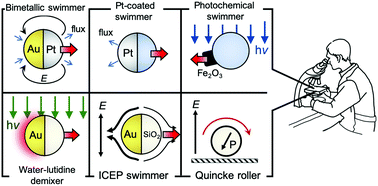A practical guide to active colloids: choosing synthetic model systems for soft matter physics research
Abstract
Synthetic active colloids that harvest energy stored in the environment and swim autonomously are a popular model system for active matter. This emerging field of research sits at the intersection of materials chemistry, soft matter physics, and engineering, and thus cross-talk among researchers from different backgrounds becomes critical yet difficult. To facilitate this interdisciplinary communication, and to help soft matter physicists with choosing the best model system for their research, we here present a tutorial review article that describes, in appropriate detail, six experimental systems of active colloids commonly found in the physics literature. For each type, we introduce their background, material synthesis and operating mechanisms and notable studies from the soft matter community, and comment on their respective advantages and limitations. In addition, the main features of each type of active colloid are summarized into two useful tables. As materials chemists and engineers, we intend for this article to serve as a practical guide, so those who are not familiar with the experimental aspects of active colloids can make more informed decisions and maximize their creativity.

- This article is part of the themed collection: Soft Matter Most Popular 2020


 Please wait while we load your content...
Please wait while we load your content...